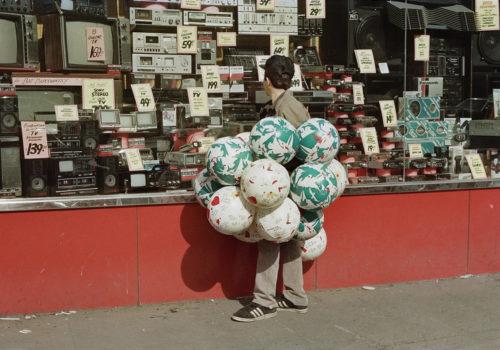Tria Giovan resides in New York. She was born in Chicago, Illinois and raised on St Thomas, US Virgin Islands. She is a documentarian and color photographer drawn to subjects that intertwine the personal and observational. The in-depth and long-term nature of her projects is driven by curiosity, emotional connection, and a desire to create informed images that reflect a humanistic engagement with the external world.
Four published monographs include: Loisaida New York Street Work 1984 – 1990 by Damiani 2023, Cuba The Elusive Island by Harry N. Abrams in 1996, Sand Sea Sky by Damiani in 2012, and The Cuba Archive Photographs 1990 to 1996 by Damiani in 2017. Exhibited in the US and internationally, Giovan’s work is held in the collections of The Museum of Modern Art, The Brooklyn Museum, The Parrish Art Museum, The Library of Congress, and The NY Public Library, among other institutions and private collections.
WEBSITE:www.triagiovanphotography.com
Book sales:
Loisaida New York Street Work 1984 – 1990 by Damiani Books May 2023
ISBN 9788862087872
Available at your local book stores.
Currently on view:
Viewing Room Exhibition at The Crane Kalman Brighton Gallery to September 30, 2023
https://cranekalmanbrighton.com/viewing-room/
Patricia Lanza: Discuss Loisaida, New York’s Street Work. What is the significance of the title, its history, and how you came to produce this series?
Tria Giovan: In 1984, my first apartment in New York City was in a tenement building on the Lower East Side. Loisaida-a Spanish-English melding-was an affectionate and widely used name for the neighborhood.
The 1980s Lower East Side was gritty. It had a reputation for being dangerous and drug infested. I found it to be a vibrant family neighborhood with successful local business and a diverse population. I spent much of my free time wandering the streets photographing the neighborhood and it’s melding cultures and humanity. Additionally, I always had my camera ready at my apartment window as it was like an ongoing opera in the streets below. I loved living there.
In 1990 I left the neighborhood, got busy with assignments, and began photographing in Cuba. The Loisaida negatives, relegated to boxes, were rediscovered during the pandemic. Honestly, I had no idea I had taken so many photographs. Editing and producing the work after nearly 40 years was enlightening and exciting.
Time has added an historical significance to the images, but I also view the work through a contemporary prism that considers the evolution of a neighborhood and the medium of photography, as well as my development as an artist. Part preservation and part humanistic engagement, it is ultimately a time capsule of the always evolving, evocative Lower East Side.
Lanza: Your photographic work especially several publications focus on Hispanic culture, how did this evolve?
Giovan: In hindsight, it is interesting that there is Hispanic or Caribbean culture represented in both Loisaida Street Work and The Cuba Archive. It wasn’t planned. I ended up in the predominately Dominican neighborhood because it was affordable. However, having grown up in bustling Charlotte Amalie on St Thomas, in the Virgin Islands, there were similarities despite being dramatically different. The colors, noises and the way life was lived on the streets seemed familiar and drew me in.
My interest in Cuba derived more directly from witnessing the development of the islands during the 70s and 80s. My hope, perhaps driven by nostalgia, was that Cuba escaped the tourism driven fate of much of the Caribbean. In 1990 on my first visit, that was largely true, however, more compelling was Cuba’s culture, history, politics, and day-to-day life. I spent the next 6 plus years thoroughly engaged in all things Cuba related, taking over a dozen one-month trips and making over 25,000 photographs.
Both of these places resonated personally, and despite geographic differences there are similarities both in the images and in my approach in making them. Unknowingly, with Loisaida, and deliberately with Cuba, I created two distinct bodies of work that are visual records with historical importance. Capturing things before they change and disappear has always been the driving force in my photography, and never more evident than with these works.
Lanza: Your diversified career encompasses many genres of photography: architectural interiors, landscape, seascape, culture etc. what are you working on presently?
Giovan: I am very fortunate to have had such a diverse career. I have always supported myself with a variety of assignment work, while simultaneously engaging with personal long-term projects. In some ways it has been like having two careers. I am always photographing something.
Now that the Loisaida book is done, I am currently editing and producing imagery from the long-term project It Is Always Now – 1985 to the present. As a chronicle of my family, our home and its environs in coastal RI, the images address how a family’s legacy preserved with photographs has a singular point of view, while considering the concept of a collective past. I am interested in the connection between the spiritual and the material, the visual representation of intimate bonds and the metaphorical possibility of home.
Most recently, I have been photographing on the eastern end of Long Island where I now live. The project is a bit undefined at this point, but it involves portraits, landscapes, and interiors. The area is changing-physically and demographically-rapidly-so I feel compelled to photograph. I am, as always, responding to my environment and trusting my instincts.
If I may quote the Greek philosopher Heraclitus “ The only constant in life is change”.
I imagine there will always be something for me to photograph.
















